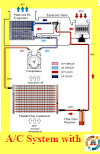COMPONENTS AIR CONDITIONING Expansion Valves
Thermal Expansion Valves
Refrigerant flow to the evaporator must becontrolled to obtain maximum cooling,
while ensuring that complete evaporation .of the liquid refrigerant takes place. This is
accomplished by the thermal expansion ,
valve (TXV).
Pressures in control
As shown in the illustration, the TXV
controls the refrigerant flow by using a
system of opposing pressures which will
call:
F1 - Temperature sensing capillary tube
Sealed tube filled with refrigerant. This
refrigerant is also filled above the
diaphragm (7). The capillary tube sensing
bulb (3) is attached to the evaporator
outlet tube surface.
F2 - Pressure compensation tube
This is a hollow tube connected to the
evaporator outlet tube and senses the
pressure of the R134a refrigerant leaving
the evaporator coil. (Other TX valves may
not use this tube as pressure is provided
internally within the valve).
F3 - Pressure spring
This spring (6) is located under the ball
valve (5).
Operation
Open
When the evaporator outlet tube
temperature increases, the refrigerant (3)
in the capillary tube expands, forcing the
diaphragm (7) downwards and thus
pushing pin (A) also downwards causing
the ball valve (5) to move away from the
metering orifice (4), allowing more R134a
to enter the evaporator inlet side.
Closed
As the evaporator outlet tube becomes
cooler, the refrigerant in the capillary tube
(3) contracts. Forces F2 and F3 cause the
diaphragm (7) and pin (A) to move upward
allowing the ball valve to move towards the
metering orifice (4), restricting the R134a
flow. The outlet tube gets warmer and the
process starts over.
kandi younes

















0 comments:
إرسال تعليق
ملحوظة: يمكن لأعضاء المدونة فقط إرسال تعليق.